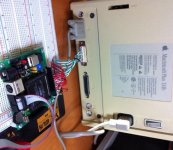There are a few "quirks" of the Mac floppy drive that would make it somewhat nontrivial to adapt the exact device you linked to (although probably doable almost solely with software changes) yes, this has been done before. (The reason the HxC emulator *has* been adapted to so many hardware platforms is that it implements the standard Shugart floppy drive interface and control protocols. Which the Mac does not use, but yes, with software changes and *possibly* a small hardware change the device could probably handle it.) The closest match with an existing device is probably the "SVD":It seems like it'd be an awful lot of work to re-implement something that has been done well, several times, already...
http://www.thesvd.com/SVD/
which already supports the Apple II with an adapter. With more memory and some software changes to understand the "statefulness" of Macintosh disk drives this device would probably already work. The reason this doesn't already exist in the Mac community has been far more a lack of "interested expertise" than any inherent difficulty in interfacing with the IWM. Yes, it's proprietary, but it's also simple and for an Apple-proprietary device extensively documented.
The "oddness" of the Mac drive probably does justify making a new device (which could also work on Apple II computers), but it does all come down to someone actually *doing* it. (Which I'm sure "Bigmessowires" is capable of, should he choose to do so.)
(EDIT: Beaten to the punch by the interested party. Oh well.)

